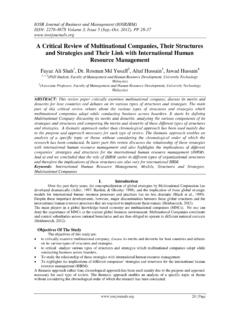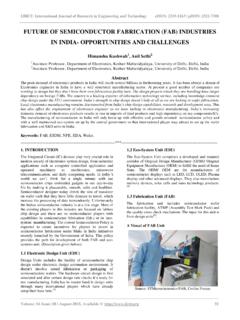Transcription of The Role of FDI in Economic Development - NOPEC 28 (2)
1 This article can be dowloaded from: Other articles from the Nordic Journal of Political Economy can be found at: Nordic Journal of Political Economy Volume 28 2002 Pages 109-126 The Role of FDI in Economic Development Kjetil Bjorvatn Hans Jarle Kind Hildegunn Kyvik Nord s Growth in foreign direct investment (FDI) isperhaps the clearest sign of globalization inthe past decade. The average annual growthrate of FDI has been 23 percent since 1986,which is twice as much as that of trade. Mostinternational investments take place withinthe OECD area.
2 However, during the 1990s,and until the Asian financial crisis in 1997, the share of FDI hosted by countries in thedeveloping world as ashare of host country GDP, FDI flows todeveloping countries are typically greater thanthose to the developed people view the presence of multi-national enterprises (MNEs) in poor coun-tries as a threat to Economic see FDI as a potential source ofeconomic growth. The present paper aims atclarifying the role of FDI in economicdevelopment and derive lessons and policyimplications. We base our study on generaltheoretical and empirical literature and onKjetil Bjorvatn NHH, Hans Jarle Kind, SNF and Hildegunn Kyvik Nord s, SNF*The Role of FDI in Economic Development *Kjetil Bjorvatn NHH, Department of Economics, The Norwegian School of Economics and BusinessAdministration, Helleveien 30, 5045 Bergen, Norway.
3 Hans Jarle Kind, SNF and Hildegunn Kyvik Nord s, SNF,Institute for Research in Economics and Business Administration, Helleveien 30, 5045 Bergen, The share increased from about 18 percent in 1990 to about 40 percent in 1994, but slipped back to about 25percent in paper deals with two questions: First, what are the determinants of foreign directinvestment (FDI)? Second, what is the role of FDI in Economic Development ? In order toprovide some answers to these questions, we draw upon the existing theoretical andempirical literature as well as insights derived from five country studies that we haveconducted.
4 Important location advantages include a stable social, political and economicenvironment, liberal trade policies, and geographical proximity to large and growingeconomies. On the host country effects of FDI, we conclude that while FDI is not neces-sary to achieve Economic Development , the entry of foreign firms may play an importantrole in adding technology and competition to the host economies. However, foreign entrymay lead to a loss in market shares, and thereby a loss in profits, for local firms. This problemis likely to be more important if foreign entry takes place in markets shielded from thecompetitive pressures of international trade.
5 JEL Classification: F23, O5702 NOPEC 28 (2) Bjorvatn 12:21 Side 109specific studies of three Asian and two paper is organized as follows. Section2 discusses the determinants of FDI. In Sec-tion 3 we turn our attention to host countryeffects of FDI, focusing on FDI s role in eco-nomic Development . The country studies arepresented in section 4. Section 5 of FDIThe most common starting point for dis-cussing firms choice of direct investment rel-ative to other entry modes in a foreign mar-ket, is Dunning s OLI framework (Dunning1977, 1981). This approach to understandingFDI is well known, and we will therefore onlybriefly mention its essential , tobe competitive in a foreign environment, afirm needs some Ownership advantage, in theform of a unique production process, apatented good, or access to more intangibleassets like reputation, trademarks and man-agement systems.
6 This competitive advantagemay be used to penetrate foreign markets indifferent ways. For a firm to choose FDI,rather than, say, exports, there must also existsome Location advantage in the foreign coun-try. Location advantages may come in differ-ent forms; firms aiming at reducing costs maybe attracted by low wages, firms wishing toexpand their international market share maybe attracted by a large home market, and soon. Finally, given that the firm has decided to produce abroad, it can choose betweenvarious contractual arrangements, includinglicensing agreements and strategic partner-ships.
7 The theory therefore predicts that theremust exist some Internalization advantagesmaking ownership preferable to more arms-length contracts. These advantages typicallyinclude a greater control over technology andreduced transaction FDIFDI is commonly classified as vertical orhorizontal. Vertical FDI involves a geographi-cal decentralization of the firm s productionchain, where foreign affiliates in low-wagecountries typically produce labour-intensiveintermediates that are shipped back to high-wage countries, often to the parent companyitself. Vertical FDI is sometimes referred to as efficiency seeking FDI, since the mainmotive for the investment is to improve thecost effectiveness of the firm s production.
8 Inthe textile and clothing industry, for example,global supply chains are common. Thecapital-intensive stages (textiles) are located in relatively capital rich countries, humancapital-intensive stages (design and up-market apparel) are located in human capitalrich countries, and labour-intensive stages(apparel) are located in labour abundantcountries. Another industry where theproduction process can easily be separatedinto stages that differ in factor intensity is theelectronics industry, which has played a majorrole in the industrialization of Malaysia.
9 A particular category of efficiency seekingFDI is sometimes referred to as technologyseeking FDI. The attraction of the locationin this case is not necessarily the low cost oflabour, but its unique competence. FDI fromindustrialized countries to the Bangaloredistrict in India, often labelled the Silicon110 Kjetil Bjorvatn, Hans Jarle Kind and Hildegunn Kyvik Nord s2. The authors have conducted four of the country studies (Kind 2000, Kind and Ismail 2001, Nord s and Pretorius2000, and Nord s 2001), while Seljeflot (2001) has conducted the fifth country study as a thesis for theSivil konom degree at NHH (with Nord sBjorvatn as supervisor).
10 The country studies build on a large numberof sources, and focus on the relationship between trade, FDI and For a discussion of the OLI framework, see Markusen (1995) and Bjorvatn (2001).02 NOPEC 28 (2) Bjorvatn 12:21 Side 110 Valley of Asia, is presumably motivated bothby cost efficiency and access to an advancedIT milieu. Indeed, India has the second largeststock of IT specialists in the world, onlysurpassed by the FDIH orizontal multinational companies producethe same product in multiple plants, andservice local markets through affiliateproduction rather than through exports fromthe home country of the of theglobal FDI is horizontal.





